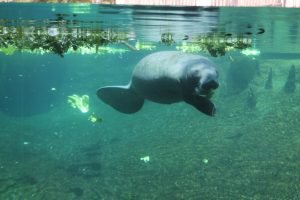When is the Best Time to See Manatees?
December 7, 2022

One of our most common questions is, "When is the best time to see the manatees?" While this answer varies based on the day, we will explain how we come up with an answer so that you can informatively choose your adventure!
First and foremost, we are the only company in the world that sees manatees year around in the wild! Why is this? Our tours take place 6.5 miles up river from the Gulf of Mexico in the Faka Union Canal. The Fakahatchee fresh water river empties out over a dam into the Faka Union Canal. This makes our water in the Port of the Island's brackish. This fresh drinking water attracts the manatees year around! They cannot survive without fresh water to drink.
Another reason they take haven in our canal is for the warmth. The bottom of the Faka Union Canal is muddy vs. sandy like the Gulf of Mexico. A muddy bottom holds heat better than a sandy bottom. Because of this, they seek the warmer water between November-April. Fun fact: manatees cannot survive in water below 68 degrees Fahrenheit!
So, we have two factors on our side that produce manatee sightings year around: fresh water and warmer temperatures!
Now, based on seasons, the rumor is true that manatees are more abundant in the winter months. Most places, you will only be able to see the manatees for a few months when the water temperature dips. What this means for us is that we just see an influx of the number of manatees. No matter what time of year you come, our success rate of seeing manatees is over 90%. But if you are here in the winter months, you will see a higher number of manatees.
Many people call to inquire about what time is best to see manatees on a particular day. There are two factors in play here: daylight, and the tides. The best viewing happens when the sun is the highest which typically tends to fall during our 10 am, 11:30 am and 1 pm tours. Manatees are also more easily seen 2 hours before and 2 hours after the peak of an incoming tide. They float in with the tide to conserve energy...talk about working smarter not harder! So, we recommend checking for the incoming tide on the day of your desired trip, and then comparing it with the daylight to choose the best tour for you.
We hope this information helps in deciding which time to choose for your manatee sightseeing adventure. Regardless of what you choose, remember, our success rate is over 90% and we will try our hardest to get you up close to manatees, alligators, birds and bull shark! While wildlife is unpredictable and cannot be guaranteed, we promise that if you do not see a manatee on your adventure, you get to come back for free.
So go ahead and book your manatee adventure for an experience you'll only find here in the beautiful Everglades of Naples, Florida!
The Purpose of Ecotourism
January 19, 2022

Most tourism in natural areas today does not fall under the category of ecotourism and is not, therefore, sustainable. Ecotourism is set apart by its emphasis on conservation, education, traveler responsibility and active community participation.
With the many advances in transportation and information technology, even the most remote places on our earth are within reach of the traveler. In fact, tourism is now the world’s largest industry, with nature tourism representing the fastest growing segment. People express a desire to experience nature and the world, but should make every attempt to do so in a way that does not negatively impact the natural environment.
The World Conservation Union (IUCN) defines ecotourism as, “Environmentally responsible travel to natural areas, in order to enjoy and appreciate nature (and accompanying cultural features, both past and present) that promote conservation, have a low visitor impact and provide for beneficially active socio-economic involvement of local peoples.”
Ecotourism generally possesses the following characteristics:
- Conscientious, low-impact visitor behavior
- Sensitivity towards, and appreciation of, local cultures and biodiversity
- Support for local conservation efforts
- Sustainable benefits to local communities
- Local participation in decision-making
- Educational components for both the traveler and local communities
Increased tourism to sensitive natural areas without appropriate planning and management can threaten the integrity of ecosystems and local cultures. An increase of visitors to sensitive natural areas can lead to substantial environmental degradation. Local communities and indigenous cultures can also be harmed by a large influx of visitors. Ecotourism offers an opportunity for an increase in education and activism among travelers, making them more effective supporters of conservation.